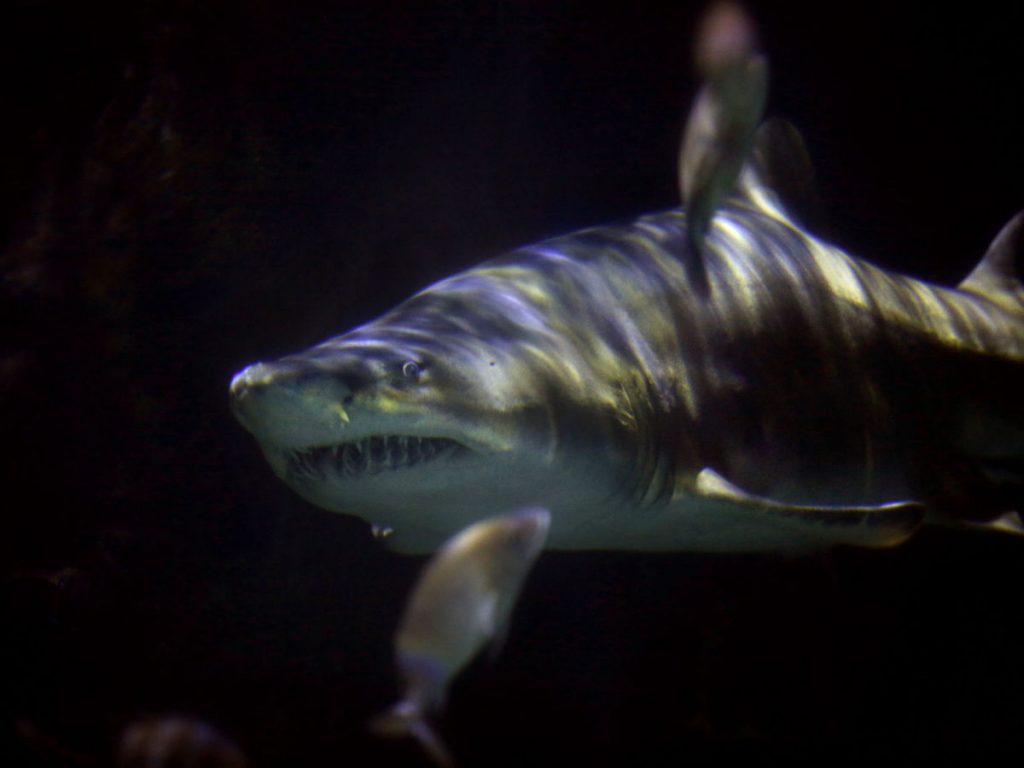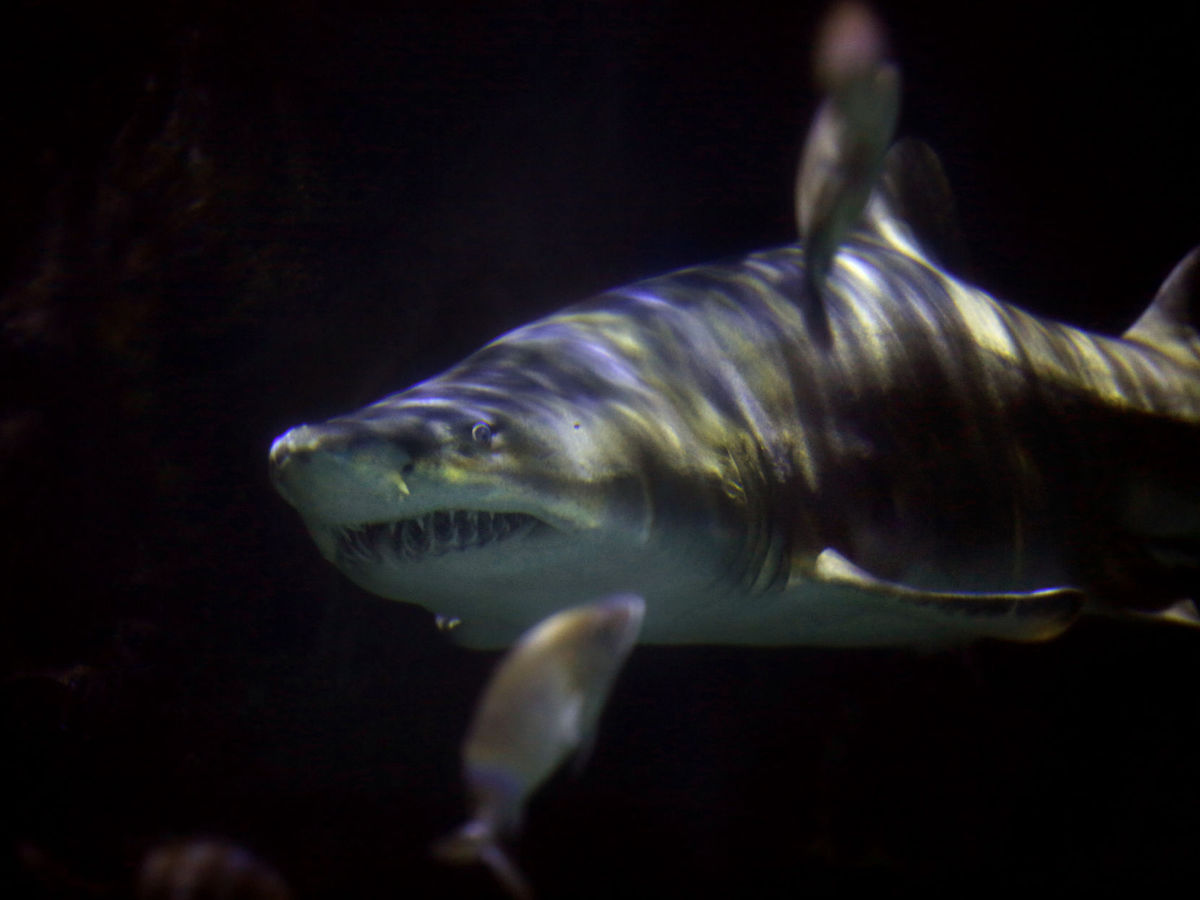Please click here for original article.
 Above: A sand tiger shark swims through the Norfolk Canyon exhibit at the Virginia Aquarium in October 2016. Photo Courtesy: Stephen M. Katz | The Virginian-Pilot
Above: A sand tiger shark swims through the Norfolk Canyon exhibit at the Virginia Aquarium in October 2016. Photo Courtesy: Stephen M. Katz | The Virginian-Pilot
About 70 miles out in the Atlantic, a canyon begins. Down steep, craggy walls draped with corals it descends some 6,000 feet, a bridge between the continental shelf and the deep, deep ocean. Creatures move in swarms so thick along stretches of this oasis that cameras simply can’t peek through.
Yes, the Norfolk Canyon is grand.
Grand enough, some admirers say, that it should be given special status as a national marine sanctuary.
For more than a year, the Virginia Aquarium and Marine Science Center has been developing a case for making the canyon part of the sanctuary system. It has company: The National Aquarium in Baltimore and the New York Aquarium are working on nominations for ocean canyons off their states as well.
“These are incredibly special places, amazing places,” said Mark Swingle, the Virginia Aquarium’s director of research and conservation.
The Atlantic canyons, of which there are more than 50, large and small, are “biological hot spots,” he said. They’re havens, feeding grounds and nurseries for thousands of species of creatures, from worms burrowing in the deepest sediments to whales breaching on the choppy surface.
Swingle is leading the push for the Norfolk Canyon, the southernmost of the big ones. He said the Beach City Council will be asked soon to adopt a resolution of support, after which a nomination will be filed before year’s end with the National Oceanic and Atmospheric Administration.
If NOAA deems the canyon worthy of consideration, an environmental impact statement would be required and public hearings scheduled.
The agency wants those who could be affected by a sanctuary to help shape how it would be created and managed, said Paul Ticco, a regional coordinator in NOAA’s sanctuaries office.
Ticco said that process could take three years, and that there’s no guarantee the Norfolk Canyon or the two others about to be nominated – Baltimore Canyon and Hudson Canyon – will end up in the NOAA system.
“I know we’d like to see them all become sanctuaries,” he said. “Will the resources be available? I don’t know.”
A Norfolk Canyon sanctuary was proposed once before, in the mid-1980s. It didn’t make the cut.
Thirteen other areas have, however, from Stellwagen Bank off Massachusetts Bay to American Samoa. The first, created in 1975 off Cape Hatteras, N.C., protects the wreck of the Monitor, the ironclad that famously fought for the Union in the Civil War.
Each sanctuary has a headquarters and a staff – the closest now being the Monitor’s in Newport News, near the Mariners’ Museum, where the ironclad’s gun turret is being preserved. Sanctuaries get money for education and research. Some have budgets of several million dollars a year.
Swingle said the Beach aquarium, a city agency, will propose housing the Norfolk Canyon sanctuary’s headquarters. He said there’s no better place, given the aquarium’s main mission of educating visitors about the nearby ocean and the life within it.
Plus, the aquarium’s centerpiece is an homage to the canyon. The 300,000-gallon tank is crowded with sharks, rays and other ocean dwellers.
That exhibit will never do justice to the diversity and immensity of the real thing, Swingle conceded. But the aquarium could stream to audiences in its theater the live feeds from explorations like those from a few years ago that piled up discoveries of new creatures and canyon features. He said sanctuary status likely would bring funding from the government and private foundations for more such expeditions.
Steve Ross, a marine science research professor at the University of North Carolina at Wilmington, co-led expeditions into the Norfolk and Baltimore canyons in 2012 and 2013. “Pathways to the abyss” are what he calls the canyons. That’s also the title of a federally funded documentary about the trips.
The project began with a ship using multibeam sonar to map the jagged terrain – including the canyons’ numerous gullies, terraces and smaller tributaries.
After that, the researchers sent down remotely operated vehicles outfitted with cameras. They unveiled forests of corals that were far bigger and more colorful and exotic-shaped than had been documented before in the mid-Atlantic. They also spied more than 120 species of fish. Among them were creatures such as the cod-like cusk that are rarely seen these days elsewhere along the East Coast but were plentiful inside the canyon walls.
Canyons “concentrate things,” Ross said. “It’s almost like a funnel.”
Huge clouds of organic matter essential to the ocean food chain drift through or are suddenly swept by fast currents. As the chain takes life, the density continues. To krill “so thick that they blocked out our cameras and lights – they would just boil out of the sediments.” To squid in schools by the thousands. And so on.
“A massive productivity system,” Ross said.
Exactly how the Norfolk Canyon and some of the other big canyons off the East Coast formed is still a mystery.
What is known is that they likely originated – or were most dramatically shaped, as we know them now – about 20,000 years ago. That was around the peak of the last ice age, when glaciers covered much of North America and average sea levels receded to about 400 feet below what they are now.
At that time, the rivers ran much farther east before reaching the sea – 100 miles farther, in the case of the Hudson. Its current channel is the easiest to trace to any of the canyons of the Atlantic.
The Norfolk Canyon doesn’t provide such a convenient explanation.
Some geologists think it was carved by the Susquehanna River, today the largest freshwater feeder of the Chesapeake Bay. Some say it might have been scrawled by other rivers like the James, perhaps in combination with the Susquehanna. Or it could be mostly the result of massive erosion from the other direction as waves clawed through thousands of years of sediments once the sea started rising again.
Those are just some of the theories.
The Norfolk Canyon is “the one that has us scratching our heads a lot,” said Jason Chaytor, a researcher for the U.S. Geological Survey in Woods Hole, Mass. He said he and other geologists are eager to spend more time studying it.
There could be opposition to the sanctuary idea.
Oil and gas exploration and mineral mining are banned in national marine sanctuaries. The proposed Norfolk Canyon sanctuary would lie at the western edge of an area off Virginia that has periodically been considered for a federal oil and gas lease. It’s possible, then, that some energy trade groups would complain.
The Navy also will scrutinize the proposal to see whether a sanctuary might interfere with exercises or ship movements. Joe Atangan, who helps oversee environmental readiness for the U.S. Fleet Forces Command, said it’s too early to offer any judgments but said Navy officials are “grateful that the aquarium reached out to us early so that we could begin developing our assessment.”
Fishermen may be the toughest sell.
The canyon and its surroundings have long been big draws for commercial and recreational fishermen who chase everything from squid to swordfish.
Skip Feller, who operates a fleet of charter boats out of Rudee Inlet, said that even if there aren’t any immediate restrictions, a sanctuary “gives them leverage down the road to say you can’t fish here anymore.”
Feller pointed out that there’s already a plan, which he supports, to ban the use of trawls, longlines and other gear along the bottom of coral-rich areas of the mid-Atlantic. “To be honest with you, I think that’s sufficient” to safeguard the canyons, he said.
Some fishermen also have cited an action by President Barack Obama last month as a reason for concern.
Obama designated a Connecticut-sized area off Cape Cod, Mass., as the Northeast Canyons and Seamounts Marine National Monument – the first such monument in the Atlantic. Activities within monuments tend to be much more restricted than in sanctuaries, and federal officials now plan to phase out all commercial fishing in the Northeast Canyons monument by 2023. Recreational fishing will be allowed to continue.
Swingle stressed that there’s no blanket prohibition on fishing within sanctuaries and said the aquarium will not seek additional limits on fishing in its nomination for the Norfolk Canyon. He said that further restrictions would be up to regulators like the Mid-Atlantic Fishery Management Council, which developed the deep-sea coral protection plan last year.
While a president can unilaterally create a monument with “the stroke of a pen,” Swingle said, sanctuaries are formed only after a long, deliberative public process in which consensus is the aim.
Clearly, though, the aquarium is aiming big. The area that it plans to nominate is a circle of about 750 square miles, with the 35-mile-long canyon roughly in the middle. Swingle said the final boundaries likely would be narrower and more irregular.
The aquarium drew the circle so wide to include some notable features not far from the canyon.
One is a spot to the south that’s among the largest known seeps of methane along the Atlantic coast. The bubbling gas, thought to be the product of thousands of years of decomposing organisms, fuels an ecosystem unique from everything around it. Bacteria oxidize the gas and, in doing so, create nutrition for vast beds of mussels.
Also inside the circle are nine shipwrecks.
One is a partially completed U.S. battleship called the Washington that was sunk intentionally in 1924 under a treaty to limit naval arms. The rest are German navy vessels surrendered after World War I. Some were blasted in 1921 by bombers under the direction of a fanatical Army general who’s credited with helping prod an anchor-dragging Navy into the new age of air power.
Some folks have taken to calling the vessels, after him, the “Billy Mitchell Fleet.”
Swingle said the combination of historic and natural resources in the proposed sanctuary should make it a strong candidate.
He said the Norfolk Canyon’s importance in the larger ecosystem will be the bigger selling point, however: “Just like we have national parks on land, it’s imperative that we protect some areas of the ocean.”
That’s vital not just for the ocean, he said, but for the entire planet.
]]>





